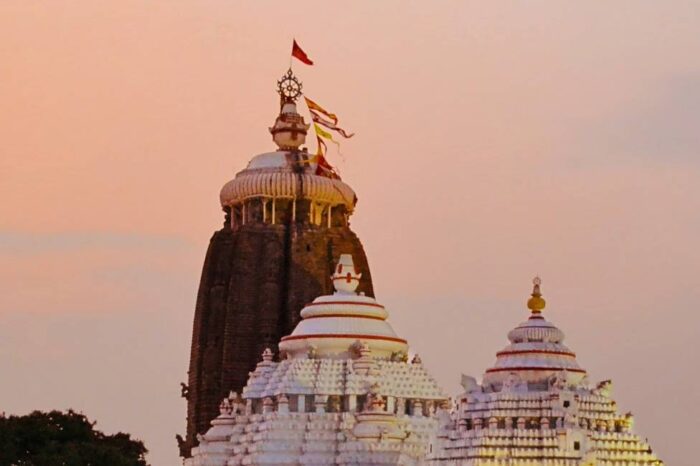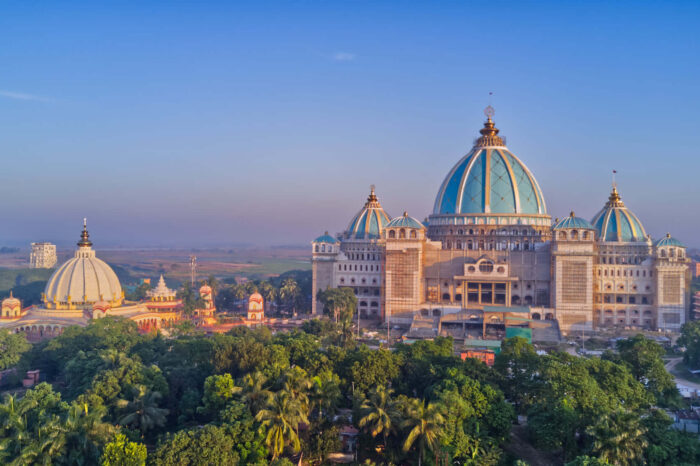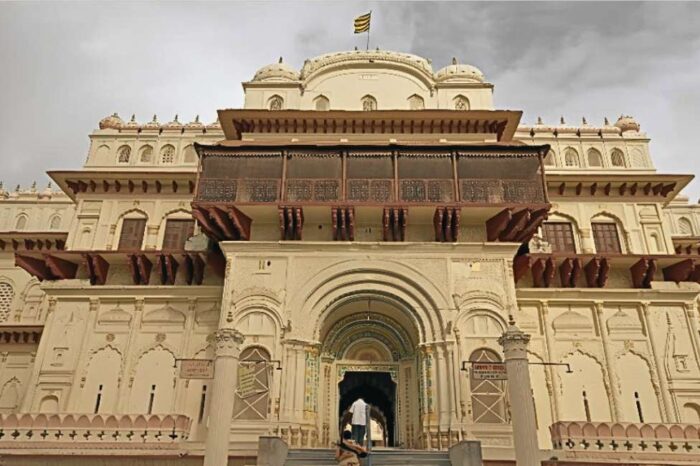- Home
- INDIA
- Offbeat India
- International
- Theme Tours
- Blogs
- Case Studies
- Plan Your Trip
Pilgrimage Tours
Pilgrimage Tours




Pilgrimage Tours offer a meaningful escape to sacred destinations, where spirituality and serenity come together. Visit revered temples, holy shrines, and ancient religious landmarks steeped in cultural and divine significance. Perfect for those seeking inner peace and spiritual enrichment, these […]
Pilgrimage Tours offer a meaningful escape to sacred destinations, where spirituality and serenity come together. Visit revered temples, holy shrines, and ancient religious landmarks steeped in cultural and divine significance. Perfect for those seeking inner peace and spiritual enrichment, these tours provide a unique blend of devotion and exploration. Whether it’s a serene retreat or a vibrant cultural experience, pilgrimage tours allow you to connect deeply with your faith and heritage while discovering the beauty of sacred landscapes.
Exploring the Spiritual Landscape of India
Introduction
India, a land imbued with spirituality and mysticism, beckons travelers to embark on a journey beyond the physical realm. This pilgrimage is not just a voyage to sacred sites but a deep dive into the soul of a culture where every stone tells a story and every ritual signifies a millennia-old tradition. From the serene ghats of Varanasi to the majestic temples of Rameswaram, Pilgrimage Tours in India unravel the tapestry of faith and devotion woven into the very fabric of Indian life. Join us as we traverse this spiritual landscape, exploring the essence of India’s revered pilgrimage destinations.
Diverse Destinations
Journeying Through West Bengal’s Spiritual Mosaic: Exploring Culture and Faith on a Pilgrimage
West Bengal, a vibrant blend of cultural richness and spiritual diversity, offers a unique experience for Pilgrimage Tours in eastern India. The state is dotted with sacred sites revered by various faiths, creating a mosaic of spiritual journeys. In Kolkata, the Dakshineswar Kali Temple and Kalighat Kali Temple stand as eminent centers of Hindu worship, drawing devotees who seek blessings from the Divine Mother. Tarapith in Birbhum, a significant seat of Tantra worship, resonates with the chants and rituals dedicated to Goddess Tara. The ISKCON headquarters at Mayapur presents a serene ambiance on the banks of the Ganges, inviting followers of the Vaishnavite tradition. Further north, in the Ganges delta, lies Gangasagar, a confluence of the holy river and the Bay of Bengal, celebrated for its auspicious Makar Sankranti mela. These destinations are cornerstones of Pilgrimage Tours in the region, offering not just religious journeys but also a deep dive into the state’s rich cultural and historical tapestry.
Embarking on the Jyotirlinga Tour: An Introduction to India’s Divine Trail
The Jyotirlinga Tour, one of the most popular Pilgrimage Tours in India, takes devotees to 12 sacred shrines of Lord Shiva. Each Jyotirlinga represents a different facet of Shiva, providing an enriching spiritual experience. Here are some of the highlights:
- Somnath, Gujarat: The first Jyotirlinga, revered for its faith and resilience.
- Mallikarjuna, Andhra Pradesh: A site rich in architectural beauty and legend.
- Mahakaleshwar, Madhya Pradesh: Famous for its Bhasma Aarti.
- Omkareshwar, Madhya Pradesh: Nestled on an Om-shaped island.
- Kedarnath, Uttarakhand: A pivotal Char Dham site high in the Himalayas.
- Bhimashankar, Maharashtra: Known for its natural beauty and forest cover.
- Kashi Vishwanath, Uttar Pradesh: In the spiritual heartland of Varanasi.
- Trimbakeshwar, Maharashtra: Famous for its architectural uniqueness.
- Vaidyanath, Jharkhand: Renowned for healing associations.
- Nageshwar, Gujarat: One of the oldest mentioned in the Shiva Purana.
- Rameshwar, Tamil Nadu: A Char Dham destination tied to the Ramayana.
- Grishneshwar, Maharashtra: Known for its carvings near the Ellora Caves.
These sacred temples form the backbone of Pilgrimage Tours that highlight India’s deep spiritual heritage.
Mandu: A Historical Interlude in the Pilgrim’s Journey
The Jyotirlinga Tour, when combined with a visit to the historical city of Mandu in Madhya Pradesh, adds a fascinating layer to Pilgrimage Tours. While the temples like Mahakaleshwar in Ujjain and Omkareshwar offer spiritual enlightenment, Mandu presents a historical retreat with its Afghan architectural wonders like Jahaz Mahal and Rani Roopmati’s Pavilion. This blend of spirituality and history makes it a unique itinerary for those seeking more from their Pilgrimage Tours.
The Confluence of Spirituality and History in Madhya Pradesh’s Pilgrimage
Madhya Pradesh is a heartland for Pilgrimage Tours, offering sacred sites like Mahakaleshwar and Omkareshwar while adding layers of historical exploration. From Jantar Mantar in Ujjain to the tranquil Ram Ghat, these tours encapsulate both devotion and culture. They are perfect for those seeking an immersive spiritual and cultural experience.
The Cultural and Religious Mosaic of Ujjain City
Ujjain, an ancient city in Madhya Pradesh, is a must-visit on Pilgrimage Tours. Dominated by the Mahakaleshwar Temple, it also features significant sites like Kal Bhairav Temple and Ram Ghat on the Shipra River. Ujjain offers a blend of devotion and history, making it a highlight of India’s spiritual landscape.
Char Dham Yatra: A Spiritual Journey Through India’s Majestic Landscapes
The Char Dham Yatra is among the most revered Pilgrimage Tours in Hinduism. Covering Yamunotri, Gangotri, Kedarnath, and Badrinath, this journey takes devotees through the serene heights of Uttarakhand. It’s not just a spiritual journey but also an adventure through some of India’s most breathtaking natural landscapes.
Sravasti, Rajgir, and Nalanda: The Historical Seats of Buddhist Learning
The Grand Buddha Tour is another key highlight in India’s Pilgrimage Tours. Covering significant Buddhist sites like Bodh Gaya, Sarnath, and Kushinagar, this tour offers profound insights into Buddhism’s history, culture, and teachings. It’s a transformative journey for those seeking spiritual and historical enrichment.
Ajanta-Ellora: A Journey Through India’s Artistic and Spiritual Legacy
Ajanta and Ellora Caves are must-visit destinations on Pilgrimage Tours that combine art and spirituality. These UNESCO World Heritage Sites feature exquisite frescoes and religious artworks, providing a glimpse into India’s ancient cultural legacy.
Do Dham Yatra: A Pilgrimage of Faith and Beauty in the Indian Highlands
The Do Dham Yatra, focusing on Kedarnath and Badrinath, is a popular option for condensed Pilgrimage Tours. These sites, steeped in religious significance and natural beauty, offer a profound spiritual journey in the majestic Indian Himalayas.
Puri Beach: A Serene Escape Beside the Holy City
Puri’s Jagannath Temple, part of the Char Dham circuit, is a cornerstone of Pilgrimage Tours in Odisha. Combined with the serene Puri Beach and the architectural marvel of the Sun Temple at Konark, this tour offers both spiritual enrichment and cultural exploration.
Ghats of Varanasi: The Spiritual Pulse of the Ganges River
Varanasi is a key destination for Pilgrimage Tours in India, with sacred sites like Kashi Vishwanath Temple and the ghats of the Ganges River. This city offers a deep dive into Hindu rituals and spiritual traditions, making it a must-visit for seekers of enlightenment.
Introduction to Pilgrimage in India
India, a land steeped in spirituality and culture, offers a unique tapestry where history and faith intertwine seamlessly. Pilgrimage holds immense significance in the daily lives of millions, serving as a profound expression of devotion. This blog will delve into the heart of India’s pilgrimage tradition, exploring diverse destinations, local customs, and the distinctive experiences that make every spiritual journey in India an extraordinary odyssey.
Travel Dynamics:
Pilgrimage in India encompasses a spectrum of travel dynamics, ranging from traditional foot journeys to modern modes of transport. Many devout pilgrims embark on arduous treks, tracing the ancient paths of their forebears, as an act of devotion and penance. These pilgrimages on foot not only connect them with the spiritual essence of the journey but also allow them to witness the changing landscapes and diverse cultures of India.
In contrast, modern transportation has made these sacred journeys more accessible. Trains, buses, and even domestic flights connect pilgrims to their destinations swiftly, making it possible for individuals from all walks of life to undertake these journeys.
Local Hospitality:
Accommodations during a pilgrimage vary widely, catering to both the humble and the discerning traveller. Ashrams, monastic retreats, provide a serene and spiritual atmosphere, often with minimal facilities but deep spiritual immersion. On the other hand, local guesthouses and lodges offer more comfort and convenience, ensuring pilgrims have a comfortable stay.
Cultural Nuances:
Every pilgrimage in India is a tapestry woven with local customs and traditions. Pilgrims partake in various rituals and ceremonies that differ from one region to another. These cultural nuances, whether it’s offering prayers at a particular time, participating in local festivals, or adhering to specific dress codes, add depth and richness to the pilgrimage experience. It’s in these nuances that pilgrims truly connect with the local culture and the spiritual legacy of the land they traverse.
Ancient Traditions, Timeless Devotion: Pilgrimage Rituals in India
Spiritual practices and rituals are the heartbeat of an Indian pilgrimage, infusing each journey with profound significance. At different sites, diverse rituals unfold, each carrying its own unique meaning. Pilgrims engage in acts of devotion, from performing ablutions in the holy waters of the Ganges to offering prayers at sunrise and sunset. The recitation of sacred mantras, the lighting of oil lamps, and the ringing of temple bells create a symphony of spirituality.
These rituals often trace their origins to ancient scriptures and legends, binding pilgrims to a timeless tradition. The circumambulation of temples, the sacred dips in rivers, and the offerings made to deities are not mere gestures but profound expressions of faith. These practices serve as a bridge between the material and the divine, allowing pilgrims to connect with the spiritual essence of India’s sacred sites in a tangible and transformative way.
Nourishing the Soul: Culinary and Cultural Encounters of Pilgrims
On the spiritual journey through India’s sacred sites, the exploration goes beyond rituals to embrace the flavours, cultural traditions, and artistic expressions that define each pilgrimage destination. This brief immersion offers a taste of the diverse and enriching experiences that await pilgrims as they traverse this culturally and gastronomically vibrant land.
Culinary Journey:
Every pilgrimage site in India boasts a distinct culinary heritage that enriches the spiritual journey. Each destination offers unique foods that pilgrims savour as a vital part of their experience. Whether it’s the delicious prasad at temples, the savoury street food of Varanasi, or the divine langar at Amritsar’s Golden Temple, these culinary delights not only nourish the body but also the soul.
Cultural Integration:
Pilgrimages are not just about visiting sacred sites; they’re about immersing oneself in the local culture. Festivals, rituals, and traditions specific to each region become an integral part of the pilgrimage experience. Pilgrims often participate in local celebrations, gaining a deeper understanding of the cultural tapestry that surrounds them.
Art and Performance:
Many pilgrimage sites are also centres of artistic expression. From classical music and dance performances in Varanasi to the exquisite temple carvings in South India, art is an inseparable part of the journey. Local artisans often showcase their craft, providing pilgrims with an opportunity to appreciate the artistic heritage of the region. These artistic and cultural elements enrich the pilgrimage, offering a holistic experience that goes beyond the spiritual.
Preserving Sanctity and Nature: Eco-Friendly Pilgrimage Practices
Sustainability is an integral facet of modern pilgrimage in India. Recognizing the environmental impact of mass tourism, pilgrims and organisers are increasingly adopting eco-friendly practices. The significance lies not only in preserving the pristine sanctity of sacred sites but also in ensuring the well-being of the planet.
These practices include waste management, minimising plastic usage, and promoting responsible travel. Pilgrims are encouraged to clean up after themselves and avoid littering, respecting the sanctity of the pilgrimage sites and the environment. Sustainable transportation options such as electric vehicles and shared rides are gaining popularity, reducing the carbon footprint of journeys. Through collective efforts, pilgrims are not only seeking spiritual enlightenment but also contributing to the conservation of India’s natural and cultural heritage.
Harmony and Heritage: Pilgrims’ Respect for Local Customs
Pilgrimage in India isn’t just a physical journey; it’s a cultural and spiritual immersion. Respecting local customs is paramount, as it fosters a harmonious coexistence between pilgrims and the communities hosting them. This includes adhering to dress codes, removing shoes before entering sacred places, and participating in rituals with reverence. Silence during meditation or prayer is often requested to maintain the sanctity of the environment. Moreover, pilgrims are encouraged to be mindful of their impact on the environment, avoiding activities that harm the fragile ecosystems surrounding these sites. By embracing these customs and nurturing a spirit of respect, pilgrims can truly connect with the essence of India’s sacred places.
Economic Empowerment: How Pilgrimage Benefits Local Communities
Sustainable pilgrimage practices extend their positive impact to the local communities hosting these sacred sites. By promoting responsible tourism, pilgrims contribute to the economic development of these areas. Local businesses, from small vendors to homestays, thrive when pilgrims choose to support them. Moreover, community-driven initiatives, such as guided tours by locals or artisanal souvenirs crafted by indigenous communities, gain prominence. Sustainable tourism also encourages the preservation of cultural heritage, as local traditions and skills are passed down through generations. Thus, while pilgrims seek spiritual growth, they inadvertently become agents of positive change, fostering a mutually beneficial relationship between travellers and the communities they encounter.
Tranquil Vistas: Where Spirituality Meets Nature’s Serenity
Many pilgrimage sites in India are nestled in serene natural surroundings, offering pilgrims not only spiritual solace but also a visual treat. The Himalayan shrines of Badrinath and Kedarnath are cradled by snow-clad peaks, providing a breathtaking backdrop for reflection. The riverside city of Varanasi exudes an ethereal charm with its ghats along the Ganges, where the rising sun bathes the sacred city in golden hues.
Southern temples like Rameswaram boast pristine beaches and azure waters, inviting pilgrims to contemplate amidst the beauty of the Bay of Bengal. The lush green landscapes surrounding many sites, such as Tirupati, create a tranquil ambiance for seekers. Additionally, the Sufi dargahs of Rajasthan often stand amidst arid desert landscapes, their quietude contrasting with the rugged terrain.
These natural settings enhance the spiritual experience, allowing pilgrims to connect with the divine in the lap of nature. The symbiosis of spirituality and natural beauty makes India’s pilgrimage sites not just religious destinations but also havens of serenity and visual delight.
Embarking on a Sacred Odyssey: Practical Tips for Pilgrimage Planning
Planning a pilgrimage tour in India requires thoughtful preparation to ensure a seamless and spiritually enriching experience. Start by researching the specific pilgrimage sites you intend to visit, understanding their historical and cultural significance.
Itinerary Planning:
Create a detailed itinerary that includes travel dates, accommodation bookings, and a list of essential sites to visit. Be mindful of the best time to visit each location, considering weather and festivals.
Travel Documentation:
Ensure you have all necessary travel documents, including identification, permits (if required), and travel insurance.
Packing Essentials:
Pack comfortable clothing suitable for the local customs, and remember to carry a scarf or shawl for temple visits. Don’t forget essential items like a hat, sunscreen, and comfortable walking shoes.
Local Cuisine:
Explore local culinary delights but prioritise food safety and hygiene. Be cautious with street food, and carry bottled water.
Respecting Customs:
Familiarise yourself with local customs and dress codes to show respect to the sacred sites and the local population.
Health Precautions:
Consult a healthcare professional for vaccinations and carry a basic medical kit.
Eco-Conscious Travel:
Embrace eco-friendly practices, such as minimising plastic usage and disposing of waste responsibly.
Cultural Sensitivity:
Respect local traditions, maintain decorum during rituals, and engage with locals with humility.
Guides and Local Assistance:
Consider hiring local guides who can provide insights into the history and culture of the area.
Safety Measures:
Stay informed about the safety situation in the regions you plan to visit and follow government advisories.
From Faith to Knowledge: The Educational Depth of Pilgrimage Tours
Pilgrimage tours in India offer a unique opportunity for profound learning. These spiritual journeys transcend faith and delve into the realms of history, culture, and religion. As pilgrims visit sacred sites, they immerse themselves in the rich tapestry of India’s past, discovering the historical events, legends, and architectural marvels associated with each destination. This firsthand exploration fosters a deeper understanding of the complex and diverse religious traditions that have thrived in India for centuries. Moreover, interactions with local scholars and experts often provide invaluable insights, turning a pilgrimage into an enlightening educational experience that extends far beyond the spiritual realm.
Healing the Heart and Soul: Pilgrims’ Tales of Emotional Recovery
Pilgrimage tours in India are not only about visiting sacred sites; they are transformative journeys that often lead to spiritual healing and personal growth. Countless pilgrims have shared their testimonials and stories of profound transformation after embarking on these journeys.
Many describe a sense of inner peace and spiritual rejuvenation that washes over them as they stand in the presence of divine energy at these sites. The serene ambiance and the practice of meditation and introspection often lead to a heightened sense of self-awareness.
Pilgrims frequently recount stories of physical and emotional healing, crediting their experiences at these sacred places. Some have reported miraculous recoveries from ailments, while others have found solace and closure for emotional wounds.
These journeys are also a catalyst for personal growth. Pilgrims often return with a broader perspective on life, a deeper appreciation for diversity, and a stronger sense of empathy and compassion. The challenges of the pilgrimage, whether physical or spiritual, become opportunities for growth and self-discovery.
In essence, pilgrimage tours in India are not just vacations; they are transformative quests that touch the soul, heal the spirit, and foster personal growth in profound ways.
Conclusion
In the heart of India’s spiritual landscape lies a journey unlike any other – the pilgrimage tour. It’s not just a physical expedition; it’s a quest that transcends time and space, delving into the depths of faith, culture, and humanity. From the towering peaks of the Himalayas to the tranquil ghats of Varanasi, and the vibrant temples of South India to the serene dargahs of Rajasthan, each sacred site tells a story of devotion, healing, and growth. It’s a journey where pilgrims not only find solace but also rediscover themselves. So, if you seek not just a tour, but a transformation, set foot on this spiritual odyssey in the mystical land of India.
Experiences
- Chanderi SilkNovember 28, 2025
- Waterfalls of ChhattisgarhOctober 29, 2025
- Jewellery and Handicrafts of ChhattisgarhAugust 12, 2025
- Heritage Properties of ChhattisgarhAugust 12, 2025
- Tribals of ChhattisgarhAugust 12, 2025
- Chanderi Silk
Call
98742 84569
98743 61951
Mon-Sat 11.00AM-07.30PMNewsletter
Rate & Review Us
Contact Info
- +91 98742 84569
- experience@ocean6.in
- 16, Suren Tagore Rd, Ekdalia, Ballygunge, Kolkata, West Bengal 700019
- Mon - Sat : 11.00 AM - 7.30 PM
Sunday : CLOSED
Newsletter
Quick Links






































